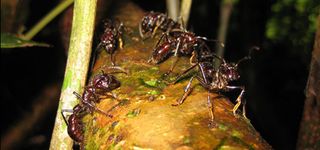Protein Shakes Make Tasty Treats For Bullet Ants

(ISNS) -- Watch a trail of ants march off bearing morsels of food, and you might think the insects are experts at gathering prey. But sometimes the makeup of a food can confound a particular species of supersized ants, new research shows.
Bullet ants – giant tropical ants named for the strength of their sting – forage for nectar and insects in the canopy of Costa Rican rainforests. When they encounter drops of a solution that's both sugary and protein-rich, they have trouble deciding whether to sip or chomp. If a liquid has high protein content, the insects grab and try to eat it as though it's solid prey. As anyone who has ever tried to eat a quickly-melting ice cream cone can imagine, the ants' attempts to bite into liquids usually fail.
Researchers have long known that bullet ants adjust how much protein or sugar to take back to their nest-mates depending on the colony's needs. But these new results, published in Naturwissenschaften last November, are the first to demonstrate what the ants detect in different morsels of food.
"This behavior isn't common to a lot of other ants," said Jenny Jandt, an entomologist at Iowa State University, in Ames, and lead author on the study. "It's one of the coolest things I've seen."
Most ants carry solid food in pincer-like jaws, called mandibles, and liquid food in a separate internal organ, the crop. But bullet ants rely on their mandibles, to do both. They sip sweet nectar and bite into protein-rich, meaty prey – whether it's a caterpillar or a liquefying insect corpse – with the same mouth parts but different movements.
The ants usually nest at the foot of trees, then climb over trunks and vines to the canopy to hunt. When a trail of ants set out, Jandt and her colleagues led them down a sugary trail to a dropper with one of 15 combinations of protein and sugar in a solution. They watched how the first ten ants in each colony approached a dropper, then switched it for another protein-sugar combination.
They found ants were more likely to drink drops that had more sugar and little protein, but chomped and pulled at drops with higher protein content. If there wasn't enough sugar to tempt them, however, the insects tended to ignore the droppers. Others attacked the droppers, or simply inspected the solutions closely.
Sign up for the Live Science daily newsletter now
Get the world’s most fascinating discoveries delivered straight to your inbox.
"I think it's a very interesting experiment," said Michael Breed, an entomologist at the University of Colorado, Boulder. He was not involved with this study, but has worked with bullet ants. "I've noticed differences in how they respond to sugars and proteins, but didn't think of pinning it down this way."
Not all ants responded the same way in this study. Some were slow, but accurate in how they handled protein-rich drops. Others acted fast, but were sloppy, and failed to sip correctly.
It's hard to tell why an individual ant behaved a certain way – partly because holding bullet ants is perilous. People who have been stung by these creatures liken it to "being shot" or having a "serrated grapefruit spoon scooping through muscle."
Although individual ants differed in their technique, the researchers noticed a trend in colonies. Some colonies had more foragers who grasped high-protein drops, while others had a significantly higher number that sipped.
However, the differences in strategy might help ant colonies adapt to fluctuating food resources in their rainforest homes, according to Jandt. Both behaviors play important roles in survival.
"If you take the time to inspect your food, it might fly away, or you might get attacked. So some ants make quick decisions, and they're not always right," Jandt explained. "Slower ants may not be as good at catching a flying bee in mid-air, but they might be better at collecting more nutritious foods."
In a fast-changing environment, bullet ants that can grab something quickly may be better survivors. Slower ants may not be as good at collecting foods quickly – but may bring more protein-rich foods home successfully, Jandt thinks.
When times are predictable, colonies where foragers employ a constant "ant see, ant grab" sort of response to food might fare well. But when environments fluctuate, colonies with more careful hunters – who scope out a food before trying to carry it off – may stand a better chance at staying nourished.
Learning what bullet ants sense in a food item – the nutrients or its physical state – is the first step to understanding how they might adapt their behavior in a changing forest.
Inside Science News Service is supported by the American Institute of Physics. Jyoti Madhusoodanan is a science writer based in San Jose, Calif. She tweets at @smjyoti.
Most Popular

